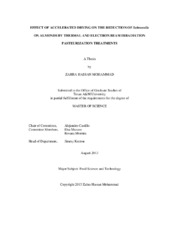| dc.description.abstract | After two outbreaks of salmonellosis that were linked to the consumption of almonds in 2001 and 2004, scientific community and industry have encouraged the study of pathogen inactivation kinetics in almonds. However, these studies often have overlooked the increase of water resulting from the inoculation of almonds. This increase of free water may result in data that may be overestimating the final outcome of treatments applied to pasteurize almonds in industrial settings. Therefore, in 2011 a study of almonds was performed at Texas A&M University to determine whether there was a need for Aw restoration. In this study, the effect of accelerated drying on the reduction of Salmonella on almonds was investigated, Salmonella Entritidis PT 30 isolated from one of the outbreaks linked to almonds, and Salmonella Typhimurium LT2 were used. For irradiation, the effect of vacuum packaging and air packaging on the sensitivity of Salmonella to e- beam irradiation was evaluated for both accelerated drying and conventional drying. The D value for Salmonella Entritidis PT 30 when treated with blanching at 88°C with accelerated drying was 10.7± 0.1 s, and 12.8 ± 0.3 s with conventional drying. When subjected to oil roasting at 127˚C, the D values were 10.5 ± 0.1 s with accelerated drying, and 10.2 ± 0.2 s with conventional drying. For irradiation treatments, the D10 value for vacuum packaged almonds was 0.35 ± 0.02 kGy with accelerated drying, and 0.38 ± 0.04 kGy with conventional drying. When irradiated in the presence of air, the D10 value of Salmonella was 0.26±0.04 kGy for almonds with accelerated drying, and 0.29 ± 0.03 kGy conventional drying. In conclusion, the accelerated drying process resulted in greater reduction in Salmonella on almonds in comparison to conventional drying when subjected to blanching but no differences were found for oil roasting (P > 0.05). For e-beam irradiation the D_10 values were significantly greater (P < 0.05) for vacuum with accelerated drying than for Air almonds with accelerated drying. This indicates that if a process applied in the industry were to be developed based on challenge studies when conventional drying was achieved, the almonds might likely be subjected to a treatment that is stronger than necessary to achieve pasteurization. | en |


